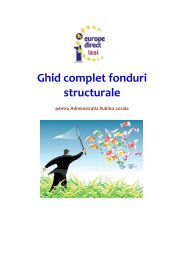Download - Europe Direct Iasi
Download - Europe Direct Iasi
Download - Europe Direct Iasi
Create successful ePaper yourself
Turn your PDF publications into a flip-book with our unique Google optimized e-Paper software.
CLASS 9 EUROINVENT 2010 CLASA 9<br />
Descriere<br />
RO<br />
yield and pulp lignin content. It was also noted that cellulosic<br />
fibers made from rapeseed stalks possess similar levels of<br />
delignification and yields as compared to those made from other<br />
wood-based and nonwood raw materials.<br />
În acest studiu, reziduurile agricole de tulpini de rapiţă<br />
(Brassica napus), au fost investigate ca sursă de materii prime<br />
pentru producţia defibre celulozice. Delignificarea tulpinilor de<br />
rapiţă s-a realizat prin metoda convenţională sulfat, în diverse<br />
condiţii de lucru. Au fost studiate influenţa adaosului de alcalii<br />
efective (16, 18, şi 20% exprimate în NaOH faţă de tulpini<br />
absolut uscate) şi temperatura maximă (150, 160, şi 170°C)<br />
asupra randamentulului şi conţinutului de lignină din fibre.<br />
Durata pentru a atinge valoarea temperaturii maxime (60<br />
minute), durata de reacţie la temperatura maximă (60 minute),<br />
precum şi raportul solid-lichid (1:5), s-au menţinut constante în<br />
toate experimentele. Rezultatele au indicat că adaosul de alcalii<br />
efective reprezintă cel mai important parametru asupra<br />
procesului de delignificare, temperatura având un efect minor<br />
asupra randamentului în fibre celulozice şi conţinutului de<br />
lignină reziduală. De asemenea, s-a observat că fibrele<br />
celulozice obţinute din tulpini de rapiţă prezintă valori similare<br />
ale gradului de delignificare şi a randamentelor cu cele ale<br />
fibrelor obţinute din alte materiale prime lemnoase şi<br />
nelemnoase.<br />
9.9.<br />
Title EN<br />
Light-stimuli azo-polymers with potential applications in<br />
biology<br />
Titlu RO Azo-polimeri cu aplicaţii în biologie<br />
Authors A. Raicu, L. Epure, S. Grama, I. Nor, N. Hurduc<br />
Institution „Gheorghe Asachi” Technical University of <strong>Iasi</strong><br />
Patent no. Pending<br />
Description<br />
EN<br />
We describe here the possibility to obtain different azopolysiloxanic<br />
structures with potential applications in biology.<br />
All the investigated polymers were obtained starting from a<br />
polysiloxane with chlorobenzyl groups in the side-chain. The<br />
first azo-polysiloxane group contains quaternary ammonium<br />
moieties, the idea being to generate photosensitive micelles,<br />
capable to aggregate/disaggregate under UV irradiation. The<br />
second group of azo-polymers presents systems capable to<br />
generate nano-structured surfaces with applications in solar<br />
energy conversion. The irradiation conditions significantly<br />
influence the surface geometry of the polymers. If the laser<br />
source is polarized, a directional material flowing can be<br />
123
















